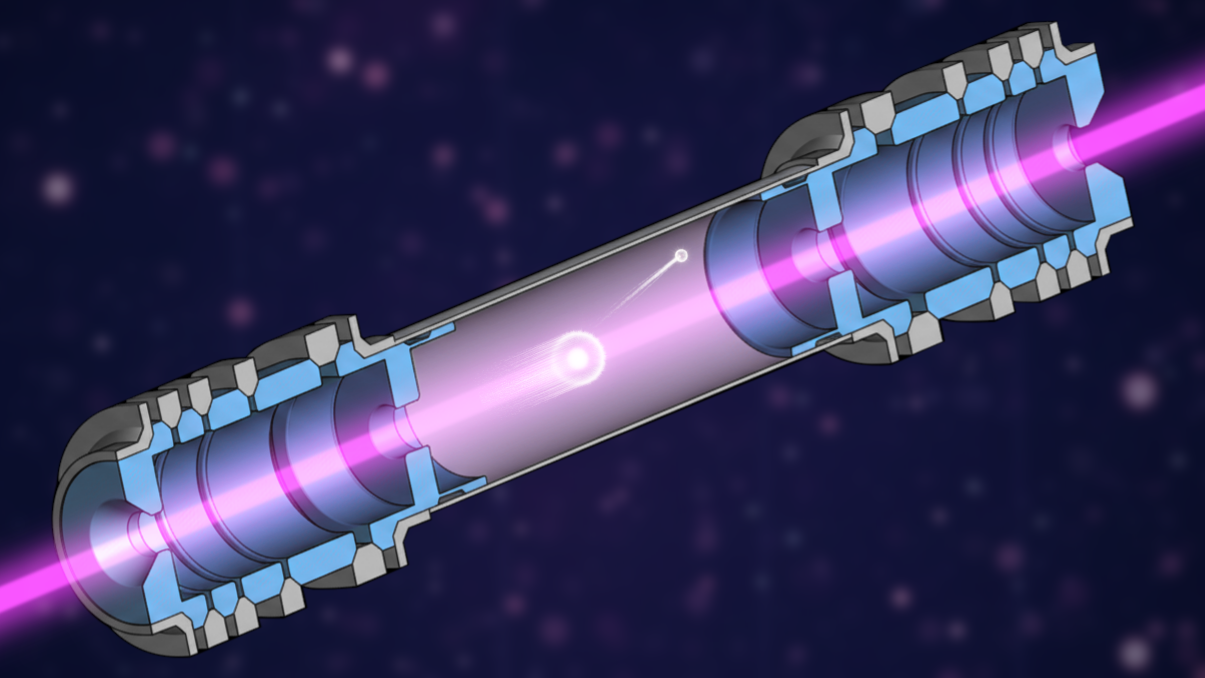
Illustration of the ion trap used by the ISOLDE team to measure the electron affinity of chlorine. In the trap, chlorine anions are reflected back and forth between two electrostatic ion mirrors, allowing the laser beam (pink) to probe the anions for much longer than in conventional measurements. The laser frequency is tuned to find the exact photon energy above which the extra electron (small white circle) is removed from the anion.
From the burning of wood to the action of medicines, the properties and behaviour of matter are governed by the way chemical elements bond with one another. For many of the 118 known elements, the intricate electronic structures of the atoms that are responsible for chemical bonding are well understood. But for the superheavy elements lying at the far edge of the periodic table, measuring even a single property of these exotic species is a major challenge.
In a new paper published in Nature Communications, a team of researchers working at the ISOLDE facility at CERN report a novel technique that could help unlock the chemistry of (super)heavy elements and has potential applications in fundamental physics research and medical treatments.
Superheavy elements are highly unstable and can only be produced in accelerator laboratories in minute amounts. This is why researchers tend to first perfect their techniques on elements that are stable and lighter.
The team at ISOLDE developed a new method based on ion trapping to measure precisely the electron affinity of chlorine, employing far fewer atoms than any previous experiment and thus opening the door to measuring this property in superheavy elements.
The electron affinity is the energy released when an electron is added to a neutral atom to form a negative ion, or "anion". It is one of the most fundamental properties of an element, determining how it forms chemical bonds.
Conventional electron affinity measurements involve sending anions of the element under investigation through the path of a laser beam. The laser frequency is then tuned to find the exact photon energy above which the extra electron from the anion is removed, which corresponds to the electron affinity of the neutral atom. However, for unstable (super)heavy elements, which are produced at a rate of a few anions per second or less, this single pass of the anions through the laser beam is insufficient to measure the electron affinity.
To overcome this limitation, the ISOLDE team trapped chlorine anions in its multi-ion reflection apparatus for collinear laser spectroscopy (MIRACLS). In this trap, the chlorine anions are reflected back and forth between two electrostatic mirrors many times like a ping-pong ball, allowing the laser beam to probe the anions during each passage.
"Despite using a hundred thousand times fewer chlorine anions, our novel MIRACLS method measures the electron affinity with precision matching that of conventional techniques, in which anions pass through the laser beam only once compared to about sixty thousand times in our experiment," says lead author of the study Franziska Maier. "Our approach essentially uses the trap's mirrors to 'recycle' the anions, opening up a path towards electron affinity measurements in superheavy elements."
Erich Leistenschneider, the second lead author of the study, adds that the properties of superheavy elements could blur the boundaries of the periodic table. "As the number of protons increases, Einstein's relativity scrambles the structure of the atoms. For this reason, one may speculate whether the boundaries between element groups in the periodic table could fade, and the chemistry of superheavy elements may deviate from the 'normal' periodic trends. The electron affinity is one of the properties that will be largely affected by those effects, and our measurements will probe them."
Beyond paving the way for measurements of the elusive electron affinities of superheavy elements, the MIRACLS approach could be applied to rare elements on Earth, including actinium, which, like astatine, is a promising candidate for creating chemical compounds for cancer treatment. It could also be used to measure the electron affinities of molecules, providing data for theoretical calculations that predict their electronic structure. Such calculations are needed for research into antimatter and radioactive molecules, which are gaining increased attention as probes of the fundamental symmetries of nature.






